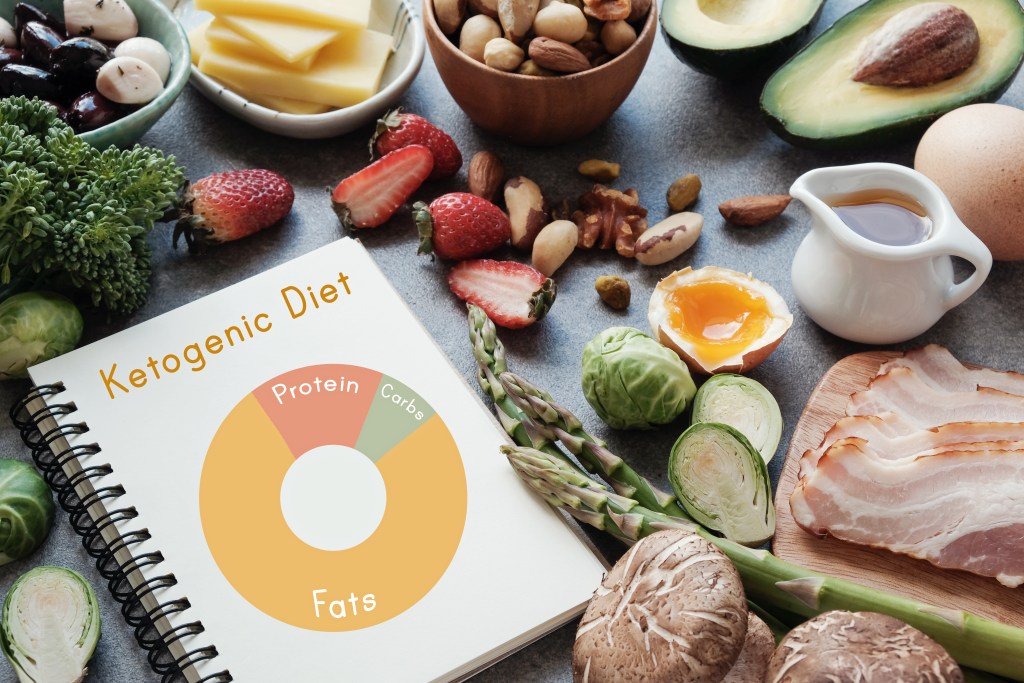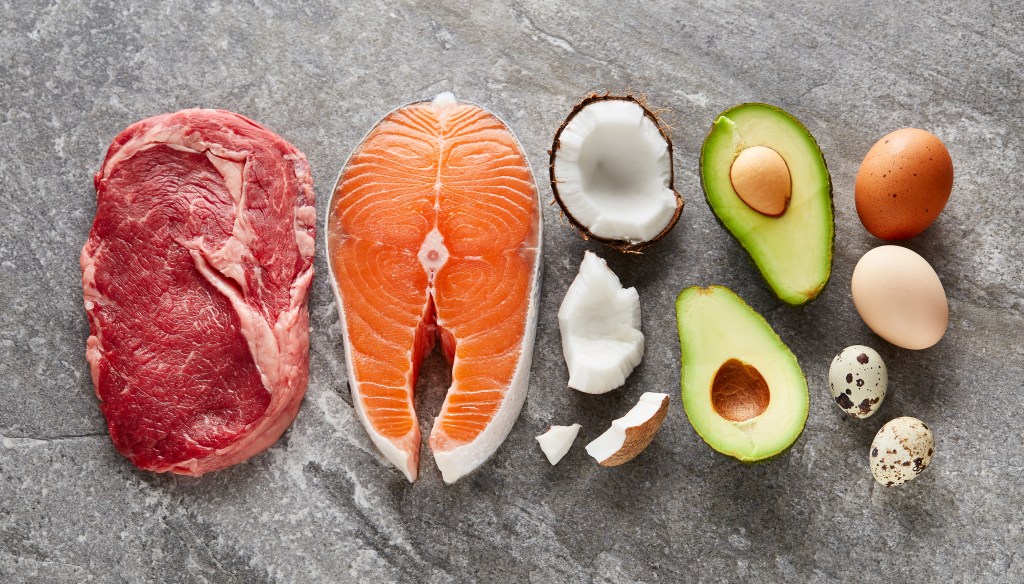The ketogenic diet is praised for its potential to promote weight loss, improve metabolic health, and enhance cognitive function.
If you recently started a low-carb diet, you may ask yourself, how much fat should I eat on keto?
Let’s look at the ideal fat intake on a ketogenic diet and discover how to incorporate enough healthy fats into your meals.
What is the keto diet?
The ketogenic diet triggers fat burning by significantly reducing carbohydrate intake and refocusing on increasing consumption of fat, protein, and vegetables.
This dietary shift induces a metabolic state known as ketosis, where the body becomes efficient at burning fat to generate energy instead of relying on glucose from carbohydrates as a fuel source.
Watch this video to learn how much fat to eat on a keto diet.
Is fat healthy?
For decades, it was widely believed that consuming fat, especially saturated fats, is the primary cause of heart disease and obesity.
However, recent findings have painted a more nuanced picture of dietary fat. Not all fatty acids are the same, and many have been found to be essential for optimal health.
For instance, medium-chain triglycerides (MCTs) in coconut oil support weight loss, reduce inflammation, and may help mitigate symptoms of metabolic syndrome.
According to research published in Frontiers in Nutrition, “Systematic studies find no significant association between saturated fat intake and coronary artery disease or mortality, and some even suggested a lower risk of stroke with higher consumption of saturated fat.”1
That said, it’s important to note that while fat is a crucial component of a healthy diet, the source and quality of the fat are important considerations.
Trans fats from seed oils, found in many processed and fried foods, have been linked to various negative health outcomes and should be avoided.
Similarly, highly processed vegetable oils contain omega-6 fatty acids that contribute to inflammation when consumed in excess.

How much fat should I eat on keto?
Determining the right amount of fat for a ketogenic diet depends on personal factors, including age, gender, activity level, and health goals.
While there’s no universal answer, there are some general guidelines that can serve as a starting point for most individuals embarking on a high-fat diet.
On a standard ketogenic diet, fat typically accounts for 60 to 80 percent of daily calorie intake. For someone consuming 2000 calories per day, this translates to a daily fat intake of 133 to 178 grams.
This may seem like a high amount, especially when compared to conventional dietary recommendations. However, fat is very calorie-dense, providing around nine calories per gram.
For example, you can obtain 85 grams of fat by consuming a salad containing half an avocado, three ounces of salmon, a quarter cup of Parmesan cheese, a quarter cup of pecans, and one tablespoon of olive oil dressing.

Keto macronutrient ratio breakdown
Understanding macronutrient ratios is crucial for successfully implementing a ketogenic diet.
While the exact ratios can vary slightly depending on individual needs and health goals, there are some guidelines you can follow.
A standard ketogenic diet typically follows a macronutrient distribution of around 60 to 80 percent of calories from fat, 20 to 25 percent from protein, and 5 to 10 percent from carbohydrates.
These ratios help you achieve and maintain ketosis by focusing on fat as the primary source of calories.
Many resources and tools are available to help you easily calculate your ideal macronutrient needs, such as this Keto Calculator, which offers a comprehensive breakdown of your ideal fat intake requirements.

Benefits of adding healthy fats to your diet
Incorporating healthy fats into your diet, especially within a well-formulated ketogenic diet, can offer numerous health benefits.
Here are four benefits of adding more healthy fats to your diet.
1. Sustained energy
Fats offer a steady source of energy, unlike carbohydrates, that can lead to rapid blood sugar spikes and energy crashes.
Once your body adapts to using fat as its primary fuel source, you’ll experience more consistent energy levels throughout the day, avoiding the mid-afternoon slump common with high-carb diets.
2. Weight management
While it might seem counterintuitive, increasing fat intake can actually aid in weight loss and weight management. Fat is very satiating, keeping you fuller for longer and reducing snacking between meals.
Moreover, pairing higher fat intake with low carbohydrate intake helps stabilize blood sugar levels. This balance minimizes cravings, especially for sweet foods, by preventing blood sugar fluctuations that trigger hunger and overeating.
The metabolic shift to fat burning promotes weight loss and more effective weight management as the body becomes more efficient at utilizing stored body fat as a fuel source.

3. Supports brain health
Approximately 60 percent of the human brain is composed of fat, which is crucial for the brain’s structural integrity and overall function.
A significant portion of this fat is in the form of cholesterol and myelin, both of which are essential for optimal brain health and cognitive processing.
Myelin, a cholesterol-rich membrane, surrounds nerve fibers and facilitates efficient transmission of electrical signals.
The brain contains about 20 percent of the body’s cholesterol. This lipid is crucial for myelin formation, insulating nerve fibers, and facilitating neural communication.
Additionally, cholesterol is the precursor to essential hormones such as testosterone, estrogen, and cortisol. Cholesterol also helps synthesize vitamin D, which is linked to a reduced risk of neurodegenerative diseases.
Research published in Protein & Cell emphasizes cholesterol’s critical role in maintaining neuronal integrity throughout a person’s life, underscoring its crucial role in hormone synthesis, forming cellular membranes, and supporting cognitive functions such as learning and memory.2
4. Heart health
Monounsaturated and polyunsaturated fats, found in foods such as extra virgin olive oil, avocados, and fatty fish, benefit heart health.
These fatty acids help increase high-density lipoprotein (HDL), also known as good cholesterol, while decreasing low-density lipoprotein (LDL), commonly called bad cholesterol, linked to heart disease.
Omega-3 fatty acids, abundant in oily fish, are particularly beneficial for cardiovascular health. They have been found to lower triglyceride levels, promote healthy blood pressure, help prevent arterial plaque buildup, and reduce the risk of arrhythmias.

How to include healthy fats in a keto diet
Incorporating healthy fats into a ketogenic diet doesn’t have to be complicated. There are many whole foods naturally high in fat that can easily be integrated into your daily meals.
Avocados, rich in monounsaturated fats, can be added to salads and smoothies or turned into a delicious keto-friendly pudding. Extra virgin olive oil is perfect for salad dressings and drizzling over roasted vegetables.
Fatty fish, such as salmon and sardines, are loaded with omega-3 fatty acids and can be used to make various tasty dishes, including Keto Salmon with Lemon Garlic Butter Sauce or Keto Tuna Patties.
Eggs are another excellent source of healthy fats and protein and can easily be included in numerous recipes or enjoyed on their own.
Additionally, coconut oil, MCT oil, butter, and ghee are all excellent fats for cooking, baking, and frying and can be added to bulletproof coffee for a quick boost of energy.
In addition to getting enough dietary fat to maintain ketosis, it’s crucial to follow a nutrient-dense, low-carb diet such as Healthy Keto®.
Healthy Keto is a variation of the ketogenic diet that integrates the macronutrient principles of standard keto with minimally processed and highly nutritious ingredients.
This means eliminating ultra-processed foods and prioritizing Healthy Keto-approved options such as organic, non-genetically modified (GMO) produce, grass-fed and pasture-raised meat, and full-fat dairy.
This dietary approach maximizes the health benefits of a ketogenic diet by providing essential nutrients, supporting metabolic health, and promoting overall well-being.

What happens if you don’t eat enough fat on keto?
When fat intake is too low on a keto diet, several issues can arise, potentially undermining the health benefits of a low-carb diet and making it difficult to maintain.
The most critical issue with not consuming enough fat on a keto diet is that it can make reaching or maintaining ketosis difficult.
The fundamental principle of a ketogenic diet is to shift your body’s primary fuel source from carbohydrates to fat.
If you’re not providing enough dietary fat, your body may struggle to produce enough ketones to fuel your cells. This can lead to fatigue, brain fog, and other symptoms commonly associated with the keto flu.
Additionally, without sufficient fat intake, the body may start to break down muscle protein for fuel in the absence of carbohydrates. This may be especially problematic for individuals with a lean body composition as they have lower body fat stores to rely on.
Additionally, fats are crucial for absorbing vitamins A, D, E, and K, and a lack of dietary fat can lead to deficiencies in these fat-soluble vitamins, negatively impacting overall health.

Who shouldn’t add fat to their diet?
While fats are an essential part of a healthy diet, certain individuals may not benefit from adding more fat to their diet.
It’s important to remember that while keto is a high-fat diet, the goal isn’t to consume excessive amounts of fat. Struggling to lose weight or uncomfortable digestive symptoms could be signs of eating too much fat.
“Hitting a weight loss plateau could indicate you’re taking in too much fat and your liver is turning dietary fats into ketones instead of burning your own body fat,” explains Dr. Berg. “You don’t want to go low-fat on keto, but you may want to try reducing your fat intake to around 75 grams per day.”
Additionally, if you introduce too much fat too quickly, the liver and gallbladder may struggle to process fats efficiently. This is especially important for individuals with conditions such as pancreatitis or liver disease.
Common signs indicating excessive fat intake include:
- Floating stools
- Bloating, burping, and belching
- Lack of weight loss despite following a ketogenic diet
- Right shoulder pain
- Pain under the right rib cage
- Right rhomboid pain
- Nausea
- Black, tarry, and oily stools
- Reduced appetite for long periods after eating
It’s crucial to discuss a ketogenic diet with your healthcare provider to minimize the risk of adverse effects, especially if you have pre-existing health conditions or are taking prescription medications.

Key takeaways
How much fat should I eat on keto?
In most cases, an ideal fat intake on keto comprises between 60 to 80 percent of your daily calories to maintain ketosis and provide sustained energy.
It’s crucial to focus on healthy fats from minimally processed whole food sources such as avocados, extra virgin olive oil, and fatty fish.
FAQ
1. How much fat should I eat a day on keto?
On a standard ketogenic diet, fat typically accounts for about 60 to 80 percent of total daily calorie needs. This means an individual consuming 2000 calories daily should aim to eat between 133 and 178 grams of fat.
2. Is consuming higher amounts of fat dangerous?
Consuming nutritious high-fat foods as part of a well-formulated low-carb diet, such as Healthy Keto, isn’t dangerous for most people.
However, it’s important to consult with a healthcare professional, especially if you have underlying medical conditions or are taking prescription medications.
3. How do I calculate my fat intake on keto?
First, calculate your daily calorie needs. Aim for 70 to 80 percent of those calories to come from fat. Then, divide the calories from fat by nine–each gram of fat provides nine calories–to determine your target fat intake in grams.
4. Will consuming more fat help you burn fat?
Yes, consuming more fat can help you burn body fat. However, it’s crucial to limit carbohydrate intake to push the body into ketosis, a metabolic state characterized by fat burning.
Consuming more fat in combination with a high-carb intake will likely cause weight gain.
5. How can I add more fat to my diet?
You can add more fat to your diet by cooking with healthy oils, eating fatty fish, adding avocado to meals, sprinkling nuts and seeds onto soups and salads, and using full-fat dairy products.
You can also incorporate fat bombs into your meals or enjoy bulletproof coffee, which is a popular high-fat beverage consumed by many individuals following a low-carbohydrate diet.
6. What is the minimum fat percentage for keto?
The minimum fat percentage for keto is typically around 60 to 70 percent of your daily caloric needs.
7. Will eating more fat knock me out of ketosis?
No, eating more fat won’t knock you out of ketosis. However, consuming excessive amounts of fat may slow down weight loss, as your body will burn dietary fat for energy before tapping into body fat stores.
Sources
- https://www.frontiersin.org/journals/nutrition/articles/10.3389/fnut.2022.878644/full ?
- https://www.ncbi.nlm.nih.gov/pmc/articles/PMC4383754/ ?








